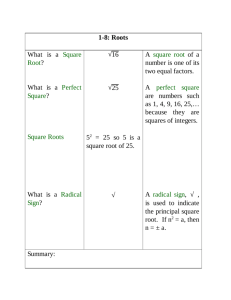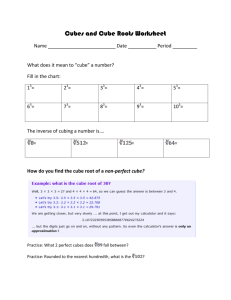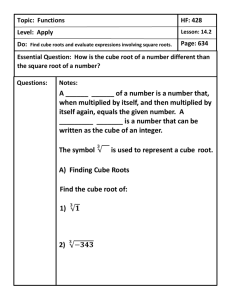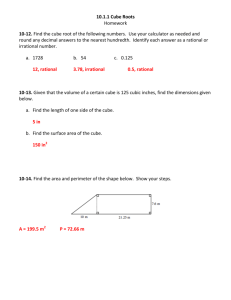Square and Cube Roots
advertisement
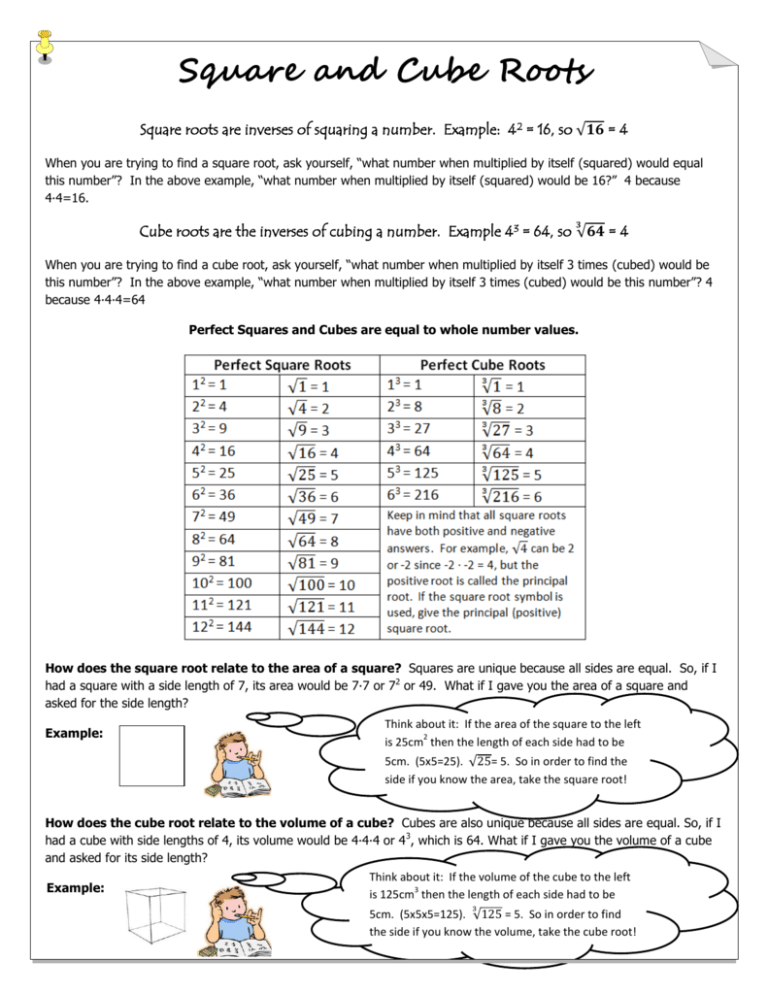
Square and Cube Roots Square roots are inverses of squaring a number. Example: 42 = 16, so =4 When you are trying to find a square root, ask yourself, “what number when multiplied by itself (squared) would equal this number”? In the above example, “what number when multiplied by itself (squared) would be 16?” 4 because 4∙4=16. Cube roots are the inverses of cubing a number. Example 43 = 64, so =4 When you are trying to find a cube root, ask yourself, “what number when multiplied by itself 3 times (cubed) would be this number”? In the above example, “what number when multiplied by itself 3 times (cubed) would be this number”? 4 because 4∙4∙4=64 Perfect Squares and Cubes are equal to whole number values. How does the square root relate to the area of a square? Squares are unique because all sides are equal. So, if I had a square with a side length of 7, its area would be 7∙7 or 72 or 49. What if I gave you the area of a square and asked for the side length? Example: Think about it: If the area of the square to the left 2 is 25cm then the length of each side had to be 5cm. (5x5=25). = 5. So in order to find the side if you know the area, take the square root! How does the cube root relate to the volume of a cube? Cubes are also unique because all sides are equal. So, if I had a cube with side lengths of 4, its volume would be 4∙4∙4 or 43, which is 64. What if I gave you the volume of a cube and asked for its side length? Think about it: If the volume of the cube to the left Example: 3 is 125cm then the length of each side had to be 5cm. (5x5x5=125). = 5. So in order to find the side if you know the volume, take the cube root! How to estimate non perfect square and cube roots? So, we know that perfect square and cube roots are perfect because they are equal to whole numbers and are therefore rational numbers. Non perfect square and cure roots are irrational. They are similar to because they are decimals that go on forever. (There is no number that when squared or cubed will actually equal exactly that number). We can ESTIMATE them. The first thing you have to do is determine between which two consecutive whole numbers the square or cube root would fall. Take a look at the number line below. Let’s find an estimate for The square root of 8 falls between 2 and 3 on the number line because the square root of 8 is between the square root of 4 and the square root of 9 (both perfect squares). Now we have to figure out which one it is closest to. The square root of 8 is really close to the square root of nine, so it is really close to 3. We can try 2.8 or 2.9. In order to find which one it is, we square each (multiply it times itself) and see which one is closer to 8 when squared. Since 7.84 is closer to 8, it is the best estimate for 2.8 X 2.8 7.84 2.9 X 2.9 8.41 ≈ 2.8 *This symbol means approximately equal *It is important to know that it doesn’t matter if the number is greater than 8, you are simply looking for the one closest to 8. What about estimating non perfect cube roots? When estimating non perfect cube roots, you still follow the same procedure. Start by looking for the two consecutive whole numbers your cube root falls between. Let’s estimate The is between the perfect cubes and which means it is between 5 and 6. It is much closer to 5 than it is 6 since it is closer to 125 than 216. We can start by trying 5.1. Remember if we are estimating a cube root, we are looking for a number when cubed equals that number, so we must multiply the number times itself three times. 5.1 5.1 X 5.1 132.651 ≈ 5.1 since 5.13 is close to 132. 5 6
